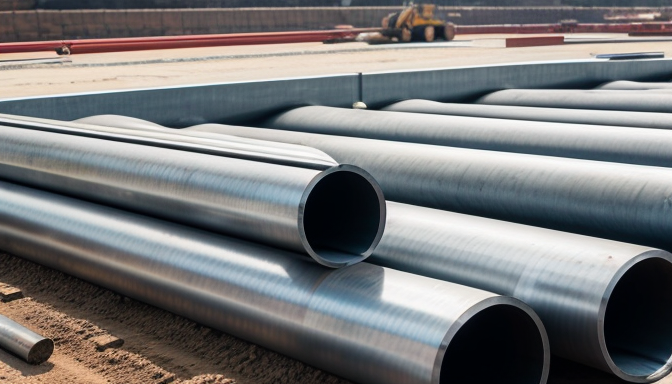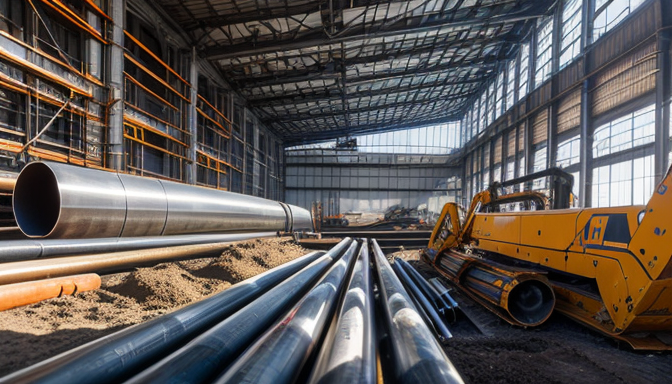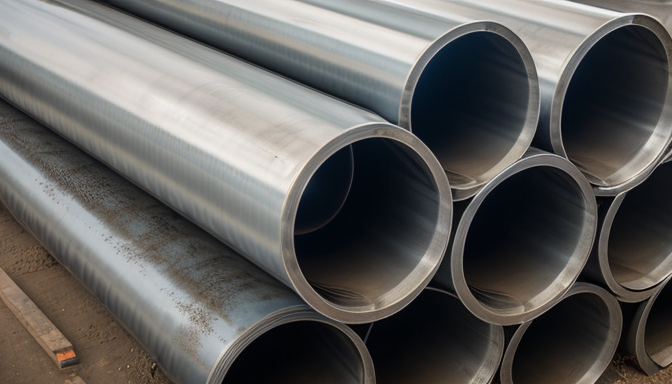Spiral welded steel pipes are an intriguing choice in the world of construction and manufacturing. Why? Because they combine strength with versatility. These pipes are made by spirally welding steel strips together, creating a robust structure that can handle various pressures and conditions. Imagine a tightly coiled spring; that’s how these pipes are designed to withstand external forces. They are not just any pipes; they are engineered for durability and longevity, making them a popular option in many industries.
When we talk about spiral welded steel pipes, it’s essential to understand their applications. These pipes are commonly used in oil and gas transmission, water supply systems, and even in structural applications. Their unique design allows for longer lengths, which means fewer joints. Fewer joints mean less chance of leaks, and that’s a big deal when you’re dealing with high-pressure systems. Isn’t it amazing how a simple design choice can enhance performance?
Now, let’s dive a bit deeper into why these pipes are so valuable. One of the standout features of spiral welded steel pipes is their cost-effectiveness. Compared to traditional straight welded pipes, spiral pipes can be produced more efficiently. This efficiency translates into savings for projects. But it’s not just about price; it’s about getting the most bang for your buck. You want a product that performs well without breaking the bank, right?
Another fascinating aspect is the variety of sizes available. Spiral welded steel pipes can be manufactured in a wide range of diameters and wall thicknesses. This flexibility allows them to cater to different project requirements. Whether you need a small pipe for a residential project or a large one for industrial use, there’s likely a spiral welded pipe that fits the bill perfectly. Think of it like shopping for clothes; you want something that suits your style and fits well. The same goes for pipes!
In summary, spiral welded steel pipes are more than just a construction material. They represent a blend of innovation and practicality. With their unique manufacturing process, they offer significant advantages in terms of durability, cost, and versatility. As we explore further into their pricing, weight, properties, and sizes, you’ll see just how essential these pipes are in today’s industrial landscape.
Spiral Welded Steel Pipe Price
Understanding the pricing factors for spiral welded steel pipes is essential for budgeting and project planning. When you dive into the world of steel pipes, you’ll find that prices can vary widely. Why is that? Well, several key factors come into play.
First off, the material quality plays a significant role. Higher quality steel will naturally cost more. And then there’s the thickness of the pipe. Thicker pipes require more material, which means a higher price tag. It’s like buying a winter coat; a thicker, warmer coat costs more than a thin one.
Another important factor is market demand. When the demand for construction materials rises, so do prices. Think of it as a game of supply and demand. If everyone wants steel pipes at the same time, prices shoot up. Conversely, when demand is low, prices typically drop. Keeping an eye on market trends can help you plan your budget effectively.
Additionally, transportation costs can influence the final price. If you’re sourcing pipes from far away, shipping fees can add up. Local suppliers often have the edge here, as they can offer better prices due to lower transportation costs. So, always consider where your materials are coming from.
| Factor | Impact on Price |
|---|---|
| Material Quality | Higher quality Higher cost |
| Pipe Thickness | Thicker pipes More material Higher price |
| Market Demand | High demand Higher prices |
| Transportation Costs | Long distances Higher shipping fees |
Lastly, don’t forget about the manufacturing process. Spiral welding is a unique method that requires specific machinery and skilled labor. This can also affect the overall cost. It’s a bit like cooking; if you want a gourmet meal, you’ll need high-quality ingredients and a skilled chef. The same goes for spiral welded steel pipes.
In conclusion, when budgeting for spiral welded steel pipes, keep these factors in mind. By understanding what influences prices, you can make more informed decisions for your projects. Whether you’re a seasoned professional or just starting out, knowing the ins and outs of pricing can save you time and money.

Spiral Welded Steel Pipe Weight
This article explores various aspects of spiral welded steel pipes, including their price, weight, properties, sizes, and uses, providing a comprehensive overview for industry professionals and enthusiasts alike.
The weight of spiral welded steel pipes is not just a number; it can change the entire game when it comes to transportation and installation. Imagine trying to lift a heavy object—it’s all about understanding the weight before you even think about moving it. The weight of these pipes is influenced by several factors, including the diameter, wall thickness, and the type of steel used. So, how is this weight calculated?
Typically, the formula to find the weight of a steel pipe is:
Weight (lbs) (π/4) × (D² - d²) × L × 0.2836
In this formula:
- D outer diameter of the pipe (inches)
- d inner diameter of the pipe (inches)
- L length of the pipe (feet)
Let’s break it down a bit more. If you have a pipe that’s 10 inches in diameter and 0.5 inches thick, you can easily plug those numbers into the formula. It’s like solving a puzzle, where every piece matters. The result gives you a solid understanding of how much the pipe weighs, which is crucial for planning transportation logistics and installation methods.
But why does weight matter? Well, consider this: heavier pipes require more robust machinery for lifting and moving. If you’re working on a construction site, you need to ensure that your team has the right equipment to handle the weight. Not to mention, shipping costs can skyrocket if you’re dealing with heavier materials. Therefore, knowing the weight helps in budgeting and project planning.
Here’s a quick reference table showing the approximate weights of common sizes of spiral welded steel pipes:
| Pipe Diameter (inches) | Wall Thickness (inches) | Weight (lbs/ft) |
|---|---|---|
| 6 | 0.25 | 6.78 |
| 8 | 0.25 | 8.62 |
| 10 | 0.375 | 13.58 |
| 12 | 0.375 | 16.52 |
In conclusion, understanding the weight of spiral welded steel pipes is essential for anyone involved in construction or manufacturing. It affects everything from transportation logistics to installation strategies. So, next time you’re planning a project, don’t overlook this critical factor. It could save you time, money, and a lot of headaches down the road.
Spiral Welded Steel Pipe Properties
When it comes to spiral welded steel pipes, understanding their properties is crucial. These pipes are not just ordinary steel tubes; they are engineered for strength and durability. Imagine them as the unsung heroes of construction, quietly supporting structures and facilitating fluid transport. But what makes them special? Let’s dive into their unique characteristics.
First off, let’s talk about mechanical properties. Spiral welded steel pipes are designed to handle high pressure and stress. Their strength comes from the way they are manufactured. The spiral welding process allows for a continuous seam, which enhances the overall structural integrity. This means they can withstand the rigors of heavy-duty applications. Think of them as the tough guys of the piping world, ready to take on any challenge.
Another important aspect is corrosion resistance. These pipes are often coated or treated to resist rust and other environmental factors. This is especially important in industries like oil and gas, where pipes are exposed to harsh conditions. The right coating can significantly extend the lifespan of a spiral welded steel pipe, making it a smart investment. It’s like giving your pipes a protective shield—keeping them safe from the elements.
Now, let’s not forget about the chemical properties. Spiral welded steel pipes are typically made from high-quality steel alloys. This means they can withstand various chemicals without degrading. For instance, in chemical processing plants, these pipes are essential for transporting liquids safely. If you think about it, they are like the veins of an industrial system, carrying vital fluids from one place to another.
To give you a clearer picture, here’s a quick overview of some key properties:
| Property | Description |
|---|---|
| Strength | High tensile strength suitable for heavy-duty applications. |
| Corrosion Resistance | Coatings available to protect against rust and environmental damage. |
| Chemical Resistance | Can handle various chemicals without degrading. |
| Flexibility | Can be manufactured in various diameters and thicknesses. |
In summary, spiral welded steel pipes are not just functional; they are designed with specific properties that make them ideal for a wide range of applications. Whether it’s their strength, resistance to corrosion, or ability to handle chemicals, these pipes play a vital role in many industries. So, the next time you see a steel pipe, remember the impressive engineering behind it. It’s more than just a pipe; it’s a vital component of modern infrastructure.

Spiral Welded Steel Pipe Sizes
When it comes to spiral welded steel pipes, size matters. These pipes are not one-size-fits-all. They come in a variety of dimensions to meet the diverse needs of different industries. But why is this so important? Well, the right size can make or break a project. It can affect not just the cost but also the efficiency and safety of the entire operation.
Typically, spiral welded pipes range in diameter from a few inches to several feet. The most common sizes are designed to accommodate various applications, whether it’s for oil and gas, water transportation, or structural purposes. For example, in the oil and gas industry, larger diameters are often required to transport high volumes of liquids. On the other hand, smaller diameters may be sufficient for residential plumbing.
So, how do you choose the right size? Here are some factors to consider:
- Application: What will the pipe be used for? Different applications have different requirements.
- Flow Rate: The amount of fluid you need to transport can dictate the diameter of the pipe.
- Pressure Ratings: Higher pressures may require thicker walls and larger diameters for safety.
To give you a clearer picture, here’s a quick overview of standard sizes:
| Diameter (inches) | Typical Use |
|---|---|
| 4 | Residential plumbing |
| 8 | Small commercial projects |
| 12 | Medium industrial applications |
| 24 | Large-scale transportation |
| 36+ | Heavy-duty industrial use |
In addition to diameter, the wall thickness is also crucial. Thicker walls can handle more pressure and are often used in high-stress environments. This means that when you’re choosing a spiral welded steel pipe, you need to consider both diameter and wall thickness together. Think of it like choosing a pair of shoes. You wouldn’t just pick any size; you want the fit to be just right for comfort and performance.
Finally, always consult with a professional or supplier to ensure you’re selecting the appropriate size for your specific project. They can provide valuable insights based on current industry standards and requirements. After all, the right size can lead to a successful project, while the wrong one can result in costly delays and safety issues.
This article explores various aspects of spiral welded steel pipes, including their price, weight, properties, sizes, and uses, providing a comprehensive overview for industry professionals and enthusiasts alike.
Understanding the pricing factors for spiral welded steel pipes is essential for budgeting and project planning. The price of these pipes can vary widely based on several factors. For instance, the quality of the raw materials plays a crucial role. High-quality steel will naturally cost more than lower-grade options. Additionally, market demand can cause fluctuations in prices. If many projects are underway, prices might rise due to increased demand. On the flip side, during a market slump, prices can drop.
Other factors include:
- Pipe Diameter: Larger pipes typically cost more.
- Length: Longer pipes may incur higher shipping costs.
- Coating: Pipes with special coatings for corrosion resistance can be pricier.
To give you a clearer picture, here’s a simple table showing average prices based on size:
| Pipe Diameter (inches) | Average Price per Foot ($) |
|---|---|
| 6 | 10 |
| 12 | 20 |
| 24 | 40 |
The weight of spiral welded steel pipes can significantly impact transportation and installation. Heavier pipes require more robust handling and support systems, which can increase overall project costs. The weight is typically calculated based on the pipe’s dimensions and the density of the steel used. A thicker wall means more weight, which can be a double-edged sword. While thicker pipes offer greater strength, they also add to transportation challenges.
Imagine trying to lift a heavy suitcase. It’s doable, but it takes more effort. The same goes for heavy pipes. They need special equipment for moving and placing them, which can slow down the project timeline.
Spiral welded steel pipes possess unique properties that make them suitable for specific applications. These pipes are known for their strength and durability. They can withstand high pressures and harsh environments, making them ideal for various industries, including oil and gas. Their resistance to corrosion is another significant advantage. This property is crucial, especially in areas where moisture and chemicals are prevalent.
Furthermore, the mechanical properties of these pipes ensure they can handle stress without deforming. This means fewer maintenance issues down the line, which is a win for project managers and engineers alike.
Available in various sizes, spiral welded steel pipes cater to different industry needs. The standard sizes range from small diameters for residential projects to large diameters for industrial applications. Choosing the right size is crucial for ensuring the pipe meets the project requirements. Factors influencing the selection include:
- Flow Requirements: Larger pipes can transport more fluid.
- Space Constraints: Sometimes, the installation area limits size options.
- Pressure Ratings: Different applications require different pressure tolerances.
In conclusion, spiral welded steel pipes are versatile and essential in many industries. Understanding their price, weight, properties, and sizes can help you make informed decisions for your projects.
Frequently Asked Questions
- What are spiral welded steel pipes used for?
Spiral welded steel pipes are commonly used in various industries, including construction, oil and gas, and water supply. Their unique design allows for efficient transport of fluids and gases, making them ideal for pipelines and structural applications.
- How is the price of spiral welded steel pipes determined?
The price of spiral welded steel pipes can vary based on several factors, including the cost of raw materials, market demand, pipe size, and manufacturing processes. It’s important to get quotes from multiple suppliers to find the best deal for your project.
- What factors affect the weight of spiral welded steel pipes?
The weight of spiral welded steel pipes is influenced by their diameter, wall thickness, and material density. Understanding these factors is crucial for planning transportation and installation, as heavier pipes may require specialized handling equipment.
- Are spiral welded steel pipes resistant to corrosion?
Yes, spiral welded steel pipes can be treated or coated to enhance their corrosion resistance. This is particularly important for pipes used in harsh environments, where exposure to moisture and chemicals can lead to deterioration over time.
- What sizes do spiral welded steel pipes come in?
Spiral welded steel pipes are available in a range of sizes, from small diameters suitable for residential projects to large diameters for industrial applications. The choice of size depends on the specific requirements of the project, including flow rates and pressure specifications.
